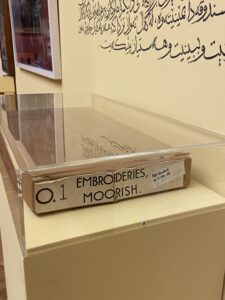A Whisper Behind the Grand Tour 2022
The ‘Rethinking the Grand Tour’ project investigates the hidden and voiceless stories behind colonialism in art and culture in Britain.
In this statement, I discuss the Hashmi dress, which holds personal meaning for me and tells a story about an object’s history and connection to people’s lives and experiences. This highlights the power of objects to connect people across the world. I also aim to raise questions about the significance of nameless heritage and precious objects. The intervention seeks to demonstrate the hidden power structures that prevent voices from being heard regarding objects brought to this country through grand tours and colonialism. This project was the reason of changing the data base system and knowledge of the Manchester Art Gallery collection, you can read more about that change through this link.
The English translation of the Kurdish text on the wall;
I’ve been meaning to ask you…
Do you know how many people’s stories, cultures, and histories are hidden within this Gallery’s collection? Have you considered the forms of power and bureaucracy which shape how these stories are told? Have you ever asked if and how the museum is willing to share these stories with you?
Have you considered whether there are objects in public collections like this one that needs urgently to be seen before they are lost? Lost to time, to forgetfulness, and to a lack of knowledge about their significance? Did you know many objects in this Gallery’s collection have been closed in dark and invisible places for a century? How long will these objects remain there? What is the point of having them if they are not seen? And, why can’t the people whose cultures from which they derive access them?
This box in front of you contains one of those objects. Can you imagine the Iraqi heritage entrapped within this box? I wish I had the power to open this box for you so that you might see some of my heritage – a beautiful Hashimi dress.
So, let me instead tell you a story about another Hashimi dress.
My mother had a very beautiful and precious one. I see it clearly in my mind’s eye. I remember all the details of the dress, its cut, its colour, and its fabric with perfect golden spangles. But after the imposition of economic sanctions on Iraq by powerful countries, including Britain, Iraqi people went through a difficult time and it was difficult to provide daily food. And so my mother had to sell her Hashmi dress to provide food for several days. Yes, she made lots of money from selling that dress, but we lost many irreplaceable memories too.
And now all these years later, I find another Hashimi dress. This time locked inside a box mislabelled with the word ‘Moorish’. The label itself is an act of barbarism that further marginalises and silences cultures, histories, people. To me, the word ‘Moorish’ might as well read ‘others’.
That is, the ‘Others’ from countries unrecognizable to the museum, the ‘others’ who don’t easily fit somewhere. The ‘Others’ who are subject to the power of museums. I wish this piece was in Iraq with my mother, aiding the memory of her beautiful Hashimi dress. Instead, it stays in this box, in company with the ‘Others’, each waiting for you to hear, see, and feel their stories.
The original Kurdish text on the wall,
مەبەستمە لێت بپرسم…
ئایا دەزانی چیرۆک و کولتوور و مێژووی چەند کەس لەناو کۆکراوەی ئەم گەلەرییەدا شاراوەن؟ ئایا ئەو فۆرمانەی دەسەڵات و بیرۆکراسیتان لەبەرچاو گرتووە کە چۆنیەتی گێڕانەوەی ئەم چیرۆکانە لە قاڵب دەدەن؟ تا ئێستا پرسیارت کردووە کە ئایا مۆزەخانەکە ئامادەیە ئەم چیرۆکانەتان لەگەڵدا باس بکات و چۆن؟
بیرت لەوە کردۆتەوە کە ئایا لە کۆکراوە تایبەتەکانیاندا شتگەلێکی وەک ئەم پارچەیە هەیە کە پێویستە بەپەلە ببینرێت پێش ئەوەی لەدەست بچێت؟ لەدەستچون بەمانای کات و لەبیرچوونەوە و نەبوونی زانیاری لەسەر گرنگییان؟ ئایا دەزانی زۆرێک لە پارچەکانی ناو کۆکراوەی ئەم گەلەرییە بۆ ماوەی سەدەیەک لە شوێنە تاریک و نەبینراوەکاندا هەڵگیراون؟ تا کەی ئەم پارچانە لەوێ دەمێننەوە؟ ئەگەر نەبینرێن چ سوودێکی هەیە هەبونیان؟ بۆچی ئەو کەسانەی کە کولتوورەکانیان لێیەوە سەرچاوە دەگرن ناتوانن دەستیان پێ بگات؟
ئەم سندوقەی لەبەردەمتدایە یەکێک لەو پارچانەی تێدایە. ئایا دەتوانی بیرلەمیراتی عێراقی بکەیتەوە کە لەناو ئەم سندوقەدا گیری خواردوە ؟ خۆزگە دەسەڵاتم هەبوایە ئەم سندوقەتان بۆ بکەمەوە، تا هەندێک لە میراتیەکانی عێراق ببینن – کە جلێکی جوانی هاشمیە.
با لەبری ئەوە چیرۆکێکتان بۆ باس بکەم دەربارەی جلێکی تری هاشمی.
دایکم یەکێکی زۆر جوان و بەنرخی هەبوو. تا ئێستا هەموو وردەکارییەکانی جلەکە و بڕینەکەی و ڕەنگەکەی و قوماشەکەی بە پولەکە ئاڵتونیەکانیەوە لەبەرچاومە. بەڵام دوای سەپاندنی سزای ئابووری بەسەر عێراقدا لەلایەن وڵاتانی زلهێزەوە، لەوانەش بەریتانیا، گەلی عێراق بە قۆناغێکی سەختدا تێپەڕی و دابینکردنی خۆراکی ڕۆژانە قورس بوو. بۆیە دایکم ناچار بوو جلە هاشمیەکەی بفرۆشێت تا بتوانێت خواردنی چەند ڕۆژێک دابین بکات. بەڵێ، ئەو پارەیەکی زۆری لە فرۆشتنی ئەو جلەدا بەدەستهێنا، بەڵام چەندین یادەوەریمان لەدەستدا کە جێگرەوەی نیە.
ئێستاش دوای ئەم هەموو ساڵە، دانەیەکی ترم بینیەوە. ئەمجارەیان لەناو سندوقێکدا قفڵ کراوە و بە هەڵە وشەی ‘مووریش’ی لەسەر نوسراوە. خودی ناوەکە کردەوەیەکی بەربەرییەتە کە زیاتر کولتوورەکان، مێژووەکان، مرۆڤەکان پەراوێز دەخات و بێدەنگیان دەکات. بۆ من، ڕەنگە وشەی ‘مۆریش’ بە هەمان شێوە ‘ئەوانی تر’ بگرێتەوە.
ئەو ‘ئەوانی تر’ ەی کەسەر بەو ووڵاتانەن کە مۆزەخانەکە نایانناسێتەوە، ئەو ‘ئەوانی تر’ ەی کە بە ئاسانی لە شوێنێکدا جێیان نابێتەوە. ئەو ‘ئەوانی تر’ ەی کە ملکەچی دەسەڵاتی مۆزەخانەکانن. خۆزگە ئەم پارچەیە لە عێراق بووایە لای دایکم تا هاوکاری بیرهێنانەوەی یادگاریەکانی بوایە. بەڵام هەر دەبێت لەم سندوقەدا بمێنێتەوە، لەگەڵ ‘ئەوانی تر’دا کە هەریەکەیان چاوەڕێی ئەوەن کە تۆ چیرۆکەکانیان ببیستیت و ببینیت و هەستیان پێبکەیت.



